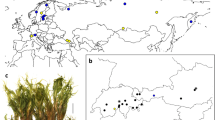Abstract
Eucharis candida andE. formosa are two often sympatric species of bulbous geophytes restricted to neotropical rain forest understory. The species are most common in eastern Ecuador, and are the only two east Ecuadorean species of the genus found north of the Pastaza valley. Data from phenetic, karyotypic, and preliminary isozyme electrophoretic analyses of both species are represented. The species are distinguishable phenetically and karyologically, but isozyme-based relationships are more complex. Phenetic resolution of the isozyme phenotypes supports recognition of two species in Ecuador. A Peruvian isolate ofE. formosa, though not morphologically distinct, shows both allozyme and chromosomal divergence from Ecuadorean populations. Cladistic relationships based on overall allozyme data do not support species distinction, but a novel electrophoretic phenotype for glutathione reductase is shared only by individuals ofE. candida. An apparent geographic component within the monophyletic groups resolved in the cladogram suggests that some degree of gene flow between these two species has been maintained without the complete loss of morpholgoical species identity. This may have been mediated either by artificial population structures due to a probable long history of cultivation, or via Pleistocene refugia effects. Both species may have originated in eastern Ecuador from a common ancestral population which has since radiated outward, perhaps several times.
Similar content being viewed by others
References
Alexander, M. P., 1969: Differential staining of aborted and non-aborted pollen. — Stain Technol.44: 177–122.
Ashton, P. S., G. Yik-Yuen, F. W., Robertson, 1984: Electrophoretic and morphological comparisons in ten rain forest species ofShorea (Dipterocarpaceae). — Bot. J. Linn. Soc.89: 293–304.
Babbel, G. R., Selander, R. K., 1974: Genetic variability in edaphically restricted and widespread plant species. — Evolution28: 619–630.
Battaglia, E., 1955: Chromosome morphology and terminology. — Caryologia8: 178–197.
Chou, C.-H., Hwang, Y.-H., Hwang, S.-Y., 1986: A biochemical aspect of phylogenetic study ofBambusaceae in Taiwan. 4. The generaArundinaria, Pseudosasa, Semiarundinaria, Shibataea, Sinobambusa, andYushania. — Bot. Bull. Academia Sinica27: 117–131.
Cormack, R. M., 1971: A review of classification. — J. Royal Statist. Soc. A.134: 321–367.
Crawford, D. J., 1983: Phylogenetic and systematic inferences from electrophoretic studies. — InTanksley, S. D., Orton, T. J., (Eds.): Isozymes in plant genetics and breeding A, pp. 257–287. — Amsterdam: Elsevier.
Farris, J. S., 1970: Methods for computing Wagner trees. — Syst. Zool.19: 83–92.
Gottlieb L. D., 1981: Electrophoretic evidence and plant populations. — InReinhold, L., Harborne, J., Swain, T., (Eds.): Progress in phytochemistry7: 46. — New York: Pergamon Press.
—, 1982: Conservation and duplication of isozymes in plants. — Science216: 373–379.
—, 1984: InGrant, W. F., (Ed.): Plant biosystematics, pp. 242–257. — Orlando, FL: Academic Press.
Hames, B. D., Rickwood, D., 1981: Gel electrophoresis of proteins. A practical approach. — Oxford: IRL Press.
Hamrick, J. L., Loveless, M. D., 1986: Isozyme variation in tropical trees: procedures and prelininary results. — Biotropica18: 201–207.
Hendy, M. D., Penny, D., 1982: Branch and bound algorithms to determine minimal evolutionary trees. — Math. Biosc.59: 277–290.
Heywood, J. S., Fleming, T. H., 1986: Patterns of allozyme variation in three Costa Rica species ofPiper. — Biotropica18: 208–213.
Janzen, D. H., 1971: Euglossine bees as long-distance pollinators of tropical plants. — Science171: 203–205.
Kaplan, J. C., 1968: Electrophoretic study of glutathione reductase in human erythrocytes and leucocytes. — Science217: 256–258.
Kirkpatrick, K. J., Decker, D. S., Wilson, H. D., 1985: Allozyme differentiation in theCucurbita pepo complex:C. pepo var.medullosa vs.C. texana. — Econ. Bot.39: 289–299.
Kluge, G., Farris, J. S., 1969: Quantitative phyletics and the evolution of anurans. — Syst. Zool.18: 1–32.
Lewis, W. H., 1986: The Jivaro Indians: notes on an expedition. — Discovery17: 2–6.
Meerow, A. W., 1987a: Biosystematics of tetraploidEucharis (Amaryllidaceae). — Ann. Missouri Bot. Gard.74: 291–309.
—, 1987b: Chromosome cytology ofEucharis, Caliphruria andUrceolina (Amaryllidaceae). — Amer. J. Bot.74: 1560–1576.
—, 1989: Systematic of the Amazon lilies,Eucharis andCaliphruria. — Ann. Missouri Bot. Gard.75: 136–220.
Nei, M., 1978: Estimation of average heterozygosity and genetic distance from a small number of individuals. — Genetics89: 583–590.
Prance, G. T., 1982a: A review of the phytogeographic evidences for Pleistocene climate changes in the Neotropics. — Ann. Missouri Bot. Gard.69: 594–624.
—, 1982b, (Ed.): Biological diversity in the tropics. — New York: Columbia University Press.
Schlarbaum, S. E., Tsuchiya, T., 1984: Cytotaxonomy and phylogeny in certain species ofTaxodiaceae. — Pl. Syst. Evol.147: 29–54.
Shaw, C. R., Prasad, R., 1970: Starch gel electrophoresis of enzymes — a compilation of recipes. — Biochem. Genet.4: 297–320.
Shields, C. R., Orton, T. J., Stuber, C. W., 1983: An outline of general resource needs and procedures for the electophoretic separation of active enzymes from plant tissue. — InTanksley, S. D., Orton, T. J., (Eds.): Isozymes in plant genetics and breeding A, pp. 443–468. — Amsterdam: Elsevier.
Sneath, P. H. A., Sokal, R. R., 1973: Numerical taxonomy. — San Francisco: W. H. Freeman.
Storey, W. B., Mann, J. D., 1967: Chromosome contraction by o-isopropyl-N-phenyl-carbamate (IPC). — Stain Technol.42: 15–18.
Sytsma, K. J., Schaal, B. A., 1985: Genetic variation, differentiation, and evolution in a species complex of tropical shrubs based on isozymic data. — Evolution39: 582–593.
Tjio, J. H., Hagberg, A., 1951: Cytological studies on some X-ray mutants of barley. — An. Estac. Exp. Aula Dei2: 149–167.
Torres, A. M., Hart, G. E., Mau-Lastovicka, T., 1982: Citrus isozymes. — J. Heredity73: 335–339.
Vallejos, C. E., 1983: Enzyme staining activity. — InTanksley, S. D., Orton, T. J., (Eds.): Isozymes in plant genetics and breeding A, pp. 469–516. — Amsterdam: Elsevier.
Author information
Authors and Affiliations
Rights and permissions
About this article
Cite this article
Meerow, A.W. Biosystematics of two sympatric species ofEucharis (Amaryllidaceae). Pl Syst Evol 166, 11–30 (1989). https://doi.org/10.1007/BF00937872
Received:
Revised:
Issue Date:
DOI: https://doi.org/10.1007/BF00937872




